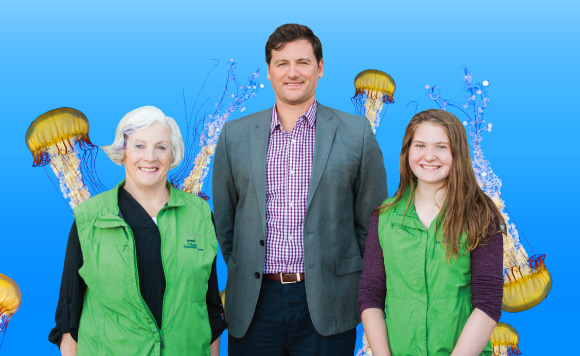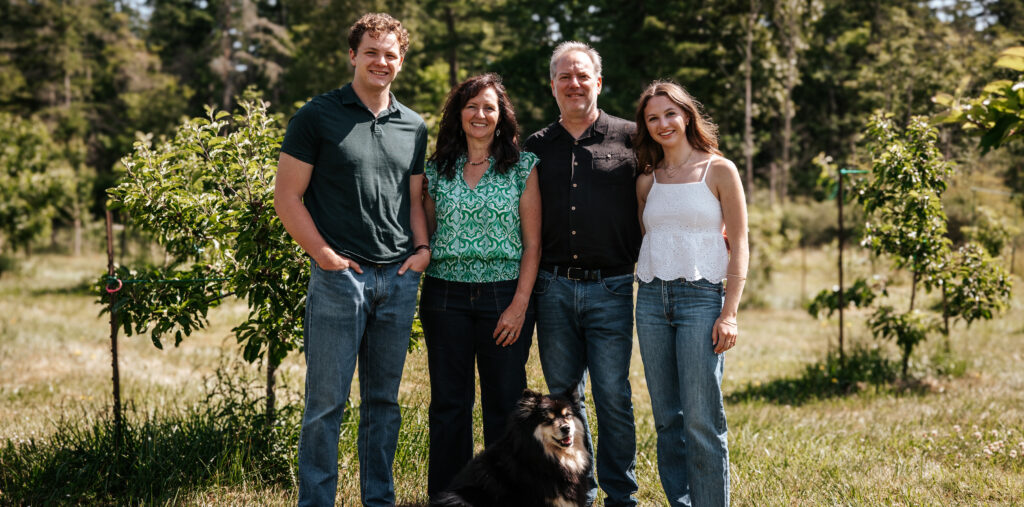In this issue of Seaside we are exploring the enormous impact volunteering has in our community. As Executive Director of Shaw Ocean Discovery Centre what would your community at the Centre look like if you didn’t have volunteers?
I’m not sure if we would exist without our volunteers. Our Centre was designed as an interpretive experience based on (mostly) volunteers delivering verbal information to visitors. Our volunteers bring an essence of, and excitement for, life-long learning: a natural curiosity; a dedication to making our societies stronger by giving back; and a deep appreciation about the conservation and protection of our environment. This ‘interaction’ between volunteers and visitors creates a space where people can spread their knowledge back and forth – discovering where people are from and what their experience with nature is – and really having these incredible conversations about the ecosystem we all live in. We are fortunate to have long-serving volunteers who have been with us since opening – many of these volunteers have moved into highly responsible positions like Mikes Patterson who works with our aquarist team and Rebecca Hansen a teen volunteer who was hired this summer as the coordinator of our first Youth Volunteer Summer Program.
Volunteering can act as a catalyst for young people to engage more effectively with other learning, or in some cases re-engage with formal learning or training, putting them in a position where they can develop skills and gain qualifications. You’ve recently launched a youth summer program aimed at introducing youth to volunteering at the Centre, with an outstanding 23 youth registered. How important is this for the Centre and what has been the outcome of this new program.
There is little argument that youth and education are the backbone of our society, so it is vital that we are constantly supporting youth development. I need to give our staff credit, specifically our long-serving Volunteer Coordinators, Beth Watkins and Kendra Fowler, who have had the vision to create this program for some time. Historically, youth volunteers (aged 13 – 17) have made up almost one third of our volunteer base. The energy and excitement that young people bring to their volunteerism is inspiring. The impact for these young people is that they learn early on how to make a difference in our society, how to be confident in front of the public and about how an aquarium operates. In return, we all win when this new generation of environmental champions will become well-rounded, educated adults and hopefully community leaders who will speak about our interconnectedness and interdependence with the natural environment, specifically the Salish Sea Bioregion.
The Shaw Ocean Discovery Centre is owned and operated by the New Marine Centre Society, a registered B.C. charity and self-supported through admission fees, grants and donations. As the newly appointed ED, and with your unique not-for-profit leadership experience, can you give us a glimpse of your goals looking ahead to the next five years?
There are many strategies the Board (also volunteer leaders in our community) and I are considering currently. Key strategies will include creating long-term financial stability given ongoing and future capital needs; developing a new, comprehensive membership program which will develop a larger constituency base and build our capacity as an organization; implementing a fundraising plan for increased individual, corporate, and government support; and, most importantly, the revitalization of our visitor experience at the Centre. The loudest feedback we hear is that our experience hasn’t changed in six years. The positive in this is that we see great potential in enhancing the experience through new signage, interactive displays, and new exhibits with a stronger focus on all aspects of the Salish Sea Bioregion. We will most likely accomplish this through key partnerships with science, cultural, technological, environmental, and First Nations organizations. Finally, a continuing strong relationship with our key funder and partner, the Town of Sidney, is essential to our growth plan. We would not exist without their support or the vision of past councillors and community leaders who were right in believing that a people’s aquarium and cultural centre would be an economic and tourist driver.
You have recently applied to the Canada 150 Community Infrastructure Program to create a new Salish Sea Legacy Gallery and an upgrade to the admissions and retail area. This grant will invest $150 million over two years to support projects that rehabilitate existing community facilities across Canada and ensure lasting legacies. If you were to receive the matching grant of $100,000, what would this mean to the centre?
The important part about this matching funding is that it jump-started and focused our vision to make a significant experience/design change, the first since opening the Centre in 2009. It fits with the ideal of our aquarium – to inform and inspire generations to explore, protect and conserve our Salish Sea – which saw us receive major funding from a similar infrastructure program allowing the Centre to be built. We see this project as leaving a substantial legacy for Canadians by building exhibits which engage discussions about biodiversity, endangered species, the traditional people of this place – the Coast Salish, healthy environments, and how understanding our local ecosystem directly translates into gaining appreciation for the global concern for a healthy Earth. In concept, the new Gallery will see an increase of 20 percent, or almost 1,200 square feet, and contain three exhibits on: Salish Sea Mammals (primarily the killer whale and grizzly bear), the Coast Salish Peoples – the water people of Canada, and an annual exhibit space focusing on the rest of the Salish Sea environment and beyond. The plan is for the gallery to be housed in the current retail space. We believe the new gallery will significantly increase our attendance, allow for long-term sponsorship funding, and properly elevate us as ‘the source’ to learn about and experience the Salish Sea anywhere in the world.
The Centre connects the public with the Salish Sea’s ecosystem through engagement, education and awareness with a hands-on, hands-wet approach to marine science and is a catalyst for conservation of marine life on Canada’s west coast. Alongside this comes building valuable business partnerships to expand on the educational resources that exist at the Centre. How important is it to build these strategic business alliances in the community?
Let’s put it this way – we are open for business (partnerships)! Our survival as an organization will be predicated upon our ability to create strategic alliances – plain and simple. Our current position though is a strong one – we have an amazing, like-new facility which was built as a community amenity and I believe will always have town and community support. My belief is that we are operating at about half of our potential regarding experience, content and global impact. We have amazing long-serving staff, volunteers, and a dedicated group of board members who genuinely care about our organization and keep it running seamlessly, on a daily basis. If our only deficiency from an experience perspective is new or changing content, then my view is that it’s a fairly easy fix – create strategic alliances with content providers. Why can’t the aquarium be the conduit for all of these agencies – universities, environment, wildlife, science, arts, culture, First Nations, and government – to share and deliver projects to potentially hundreds of thousands of people each year? We all have much to gain from this, but most importantly the public will experience a ‘wide-eyed’ global-perspective on how to contribute to making our world happy, sustainable and habitable, one person at a time.




